Strategic Analysis: United Airlines' Frequent Flyer Program Case Study
VerifiedAdded on 2022/11/13
|7
|1602
|336
Case Study
AI Summary
This case study analyzes United Airlines' Frequent Flyer Program (FFP), focusing on the application of Porter's Five Forces Model to assess the profitability of the U.S. airline industry. The analysis examines supplier and buyer power, barriers to entry and exit, substitutes, and the competitive landscape. The study evaluates the impact of the new revenue-based FFP on various stakeholders, including winners and losers, and forecasts the effects on United's customer behavior. It assesses the advantages and disadvantages of United's adoption of the revenue-based FFP. The assignment concludes with strategic recommendations for American Airlines' future FFP strategy, emphasizing the need for a dynamic and flexible approach considering consumer behavior and market trends. The analysis is supported by relevant references.
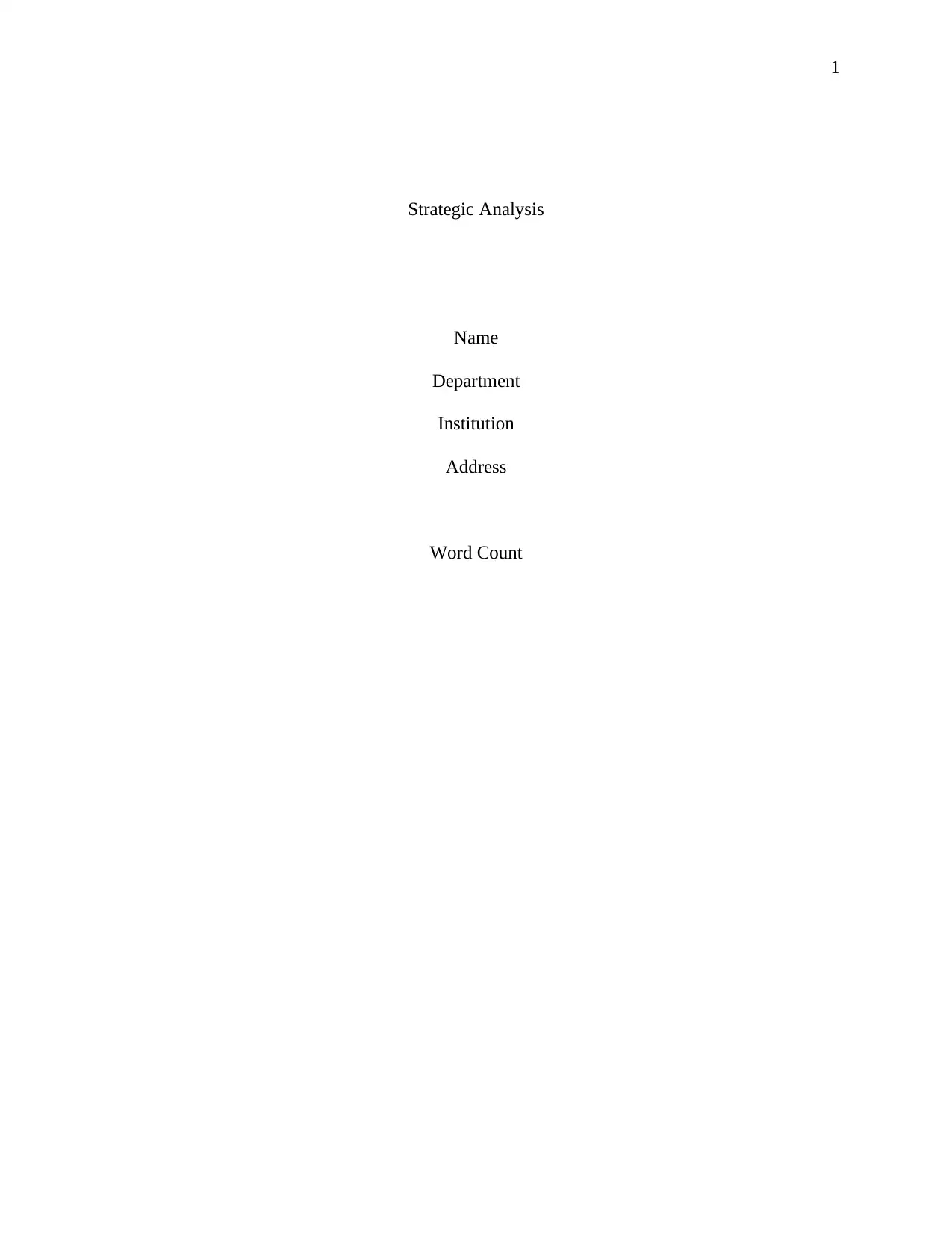
1
Strategic Analysis
Name
Department
Institution
Address
Word Count
Strategic Analysis
Name
Department
Institution
Address
Word Count
Paraphrase This Document
Need a fresh take? Get an instant paraphrase of this document with our AI Paraphraser
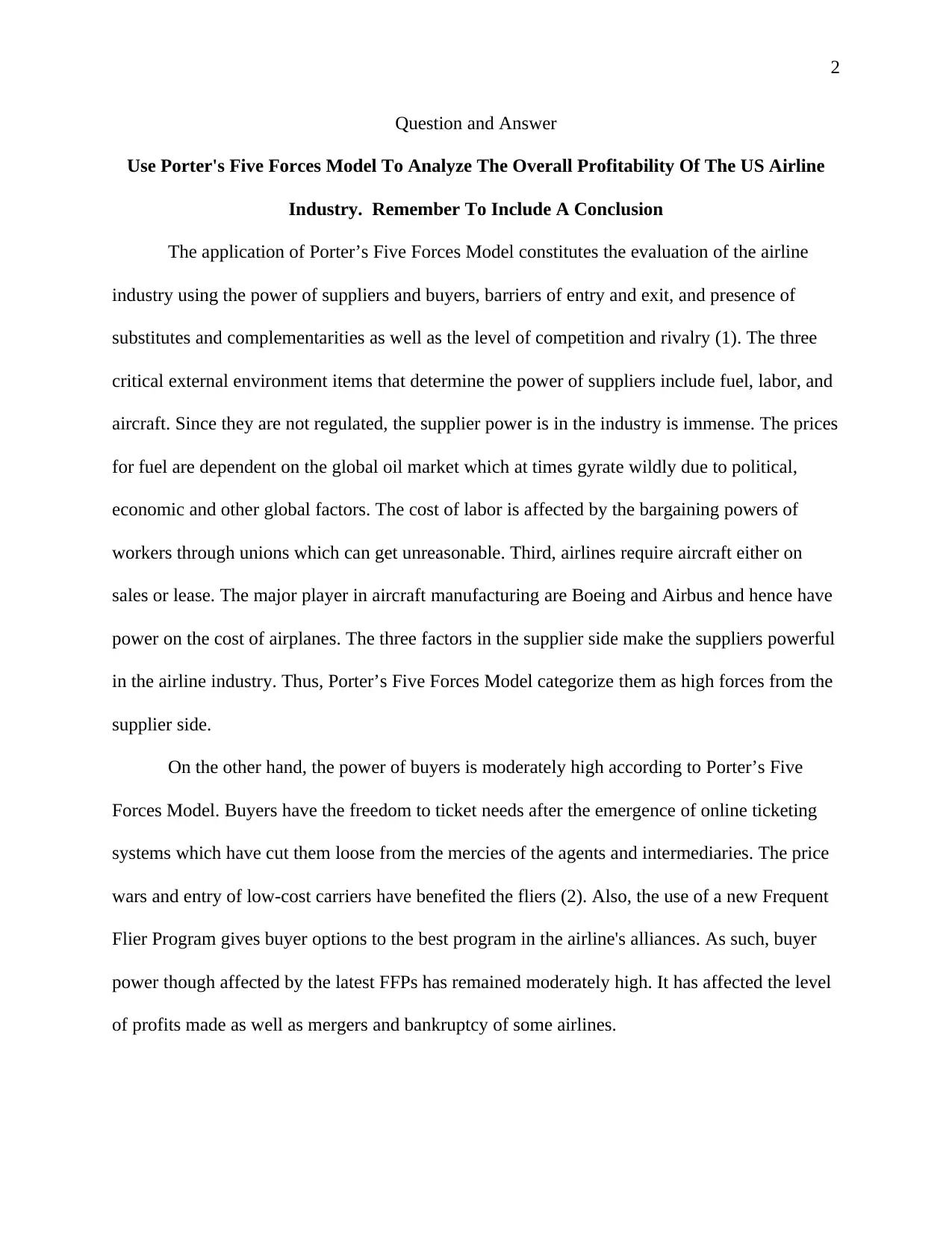
2
Question and Answer
Use Porter's Five Forces Model To Analyze The Overall Profitability Of The US Airline
Industry. Remember To Include A Conclusion
The application of Porter’s Five Forces Model constitutes the evaluation of the airline
industry using the power of suppliers and buyers, barriers of entry and exit, and presence of
substitutes and complementarities as well as the level of competition and rivalry (1). The three
critical external environment items that determine the power of suppliers include fuel, labor, and
aircraft. Since they are not regulated, the supplier power is in the industry is immense. The prices
for fuel are dependent on the global oil market which at times gyrate wildly due to political,
economic and other global factors. The cost of labor is affected by the bargaining powers of
workers through unions which can get unreasonable. Third, airlines require aircraft either on
sales or lease. The major player in aircraft manufacturing are Boeing and Airbus and hence have
power on the cost of airplanes. The three factors in the supplier side make the suppliers powerful
in the airline industry. Thus, Porter’s Five Forces Model categorize them as high forces from the
supplier side.
On the other hand, the power of buyers is moderately high according to Porter’s Five
Forces Model. Buyers have the freedom to ticket needs after the emergence of online ticketing
systems which have cut them loose from the mercies of the agents and intermediaries. The price
wars and entry of low-cost carriers have benefited the fliers (2). Also, the use of a new Frequent
Flier Program gives buyer options to the best program in the airline's alliances. As such, buyer
power though affected by the latest FFPs has remained moderately high. It has affected the level
of profits made as well as mergers and bankruptcy of some airlines.
Question and Answer
Use Porter's Five Forces Model To Analyze The Overall Profitability Of The US Airline
Industry. Remember To Include A Conclusion
The application of Porter’s Five Forces Model constitutes the evaluation of the airline
industry using the power of suppliers and buyers, barriers of entry and exit, and presence of
substitutes and complementarities as well as the level of competition and rivalry (1). The three
critical external environment items that determine the power of suppliers include fuel, labor, and
aircraft. Since they are not regulated, the supplier power is in the industry is immense. The prices
for fuel are dependent on the global oil market which at times gyrate wildly due to political,
economic and other global factors. The cost of labor is affected by the bargaining powers of
workers through unions which can get unreasonable. Third, airlines require aircraft either on
sales or lease. The major player in aircraft manufacturing are Boeing and Airbus and hence have
power on the cost of airplanes. The three factors in the supplier side make the suppliers powerful
in the airline industry. Thus, Porter’s Five Forces Model categorize them as high forces from the
supplier side.
On the other hand, the power of buyers is moderately high according to Porter’s Five
Forces Model. Buyers have the freedom to ticket needs after the emergence of online ticketing
systems which have cut them loose from the mercies of the agents and intermediaries. The price
wars and entry of low-cost carriers have benefited the fliers (2). Also, the use of a new Frequent
Flier Program gives buyer options to the best program in the airline's alliances. As such, buyer
power though affected by the latest FFPs has remained moderately high. It has affected the level
of profits made as well as mergers and bankruptcy of some airlines.
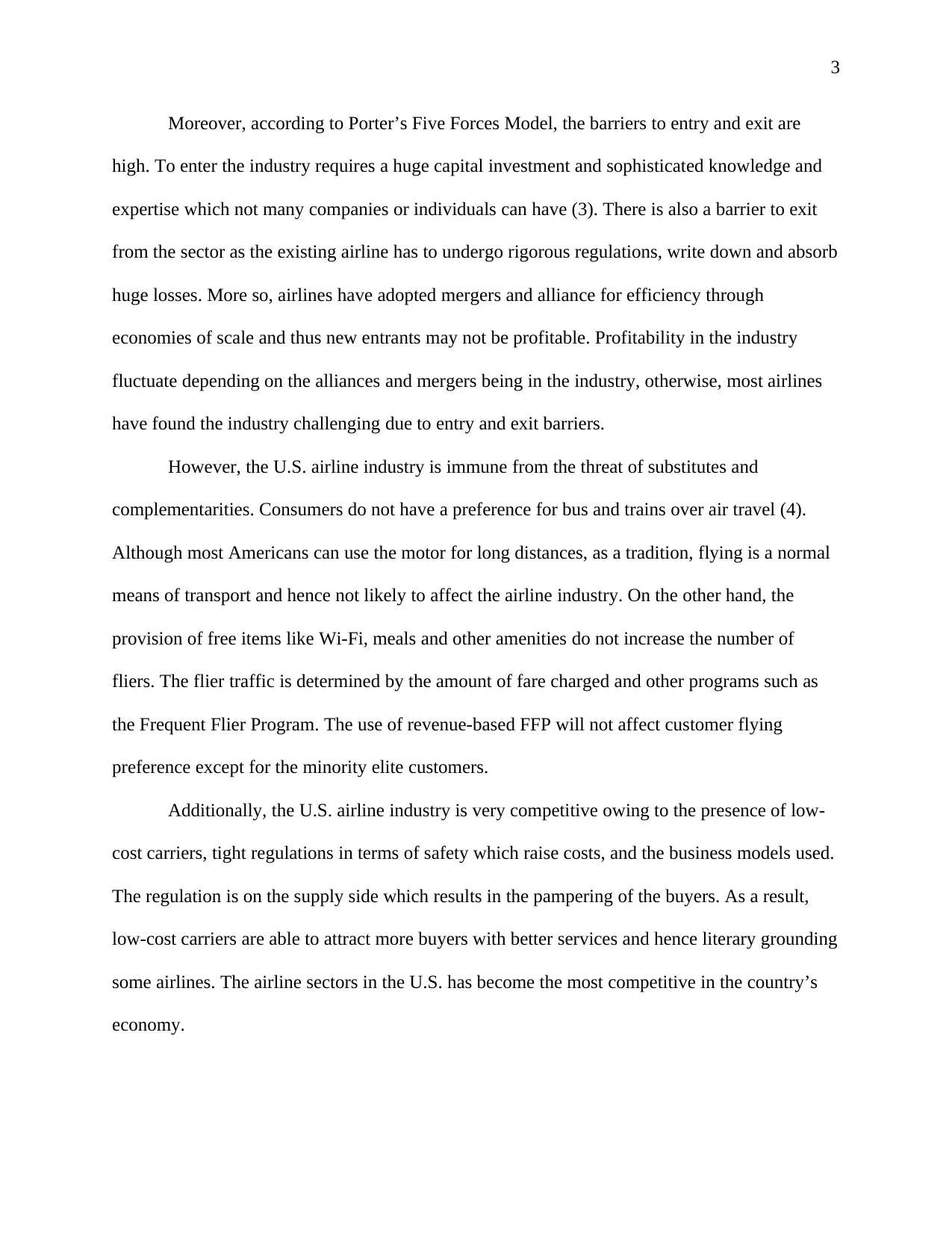
3
Moreover, according to Porter’s Five Forces Model, the barriers to entry and exit are
high. To enter the industry requires a huge capital investment and sophisticated knowledge and
expertise which not many companies or individuals can have (3). There is also a barrier to exit
from the sector as the existing airline has to undergo rigorous regulations, write down and absorb
huge losses. More so, airlines have adopted mergers and alliance for efficiency through
economies of scale and thus new entrants may not be profitable. Profitability in the industry
fluctuate depending on the alliances and mergers being in the industry, otherwise, most airlines
have found the industry challenging due to entry and exit barriers.
However, the U.S. airline industry is immune from the threat of substitutes and
complementarities. Consumers do not have a preference for bus and trains over air travel (4).
Although most Americans can use the motor for long distances, as a tradition, flying is a normal
means of transport and hence not likely to affect the airline industry. On the other hand, the
provision of free items like Wi-Fi, meals and other amenities do not increase the number of
fliers. The flier traffic is determined by the amount of fare charged and other programs such as
the Frequent Flier Program. The use of revenue-based FFP will not affect customer flying
preference except for the minority elite customers.
Additionally, the U.S. airline industry is very competitive owing to the presence of low-
cost carriers, tight regulations in terms of safety which raise costs, and the business models used.
The regulation is on the supply side which results in the pampering of the buyers. As a result,
low-cost carriers are able to attract more buyers with better services and hence literary grounding
some airlines. The airline sectors in the U.S. has become the most competitive in the country’s
economy.
Moreover, according to Porter’s Five Forces Model, the barriers to entry and exit are
high. To enter the industry requires a huge capital investment and sophisticated knowledge and
expertise which not many companies or individuals can have (3). There is also a barrier to exit
from the sector as the existing airline has to undergo rigorous regulations, write down and absorb
huge losses. More so, airlines have adopted mergers and alliance for efficiency through
economies of scale and thus new entrants may not be profitable. Profitability in the industry
fluctuate depending on the alliances and mergers being in the industry, otherwise, most airlines
have found the industry challenging due to entry and exit barriers.
However, the U.S. airline industry is immune from the threat of substitutes and
complementarities. Consumers do not have a preference for bus and trains over air travel (4).
Although most Americans can use the motor for long distances, as a tradition, flying is a normal
means of transport and hence not likely to affect the airline industry. On the other hand, the
provision of free items like Wi-Fi, meals and other amenities do not increase the number of
fliers. The flier traffic is determined by the amount of fare charged and other programs such as
the Frequent Flier Program. The use of revenue-based FFP will not affect customer flying
preference except for the minority elite customers.
Additionally, the U.S. airline industry is very competitive owing to the presence of low-
cost carriers, tight regulations in terms of safety which raise costs, and the business models used.
The regulation is on the supply side which results in the pampering of the buyers. As a result,
low-cost carriers are able to attract more buyers with better services and hence literary grounding
some airlines. The airline sectors in the U.S. has become the most competitive in the country’s
economy.
⊘ This is a preview!⊘
Do you want full access?
Subscribe today to unlock all pages.

Trusted by 1+ million students worldwide
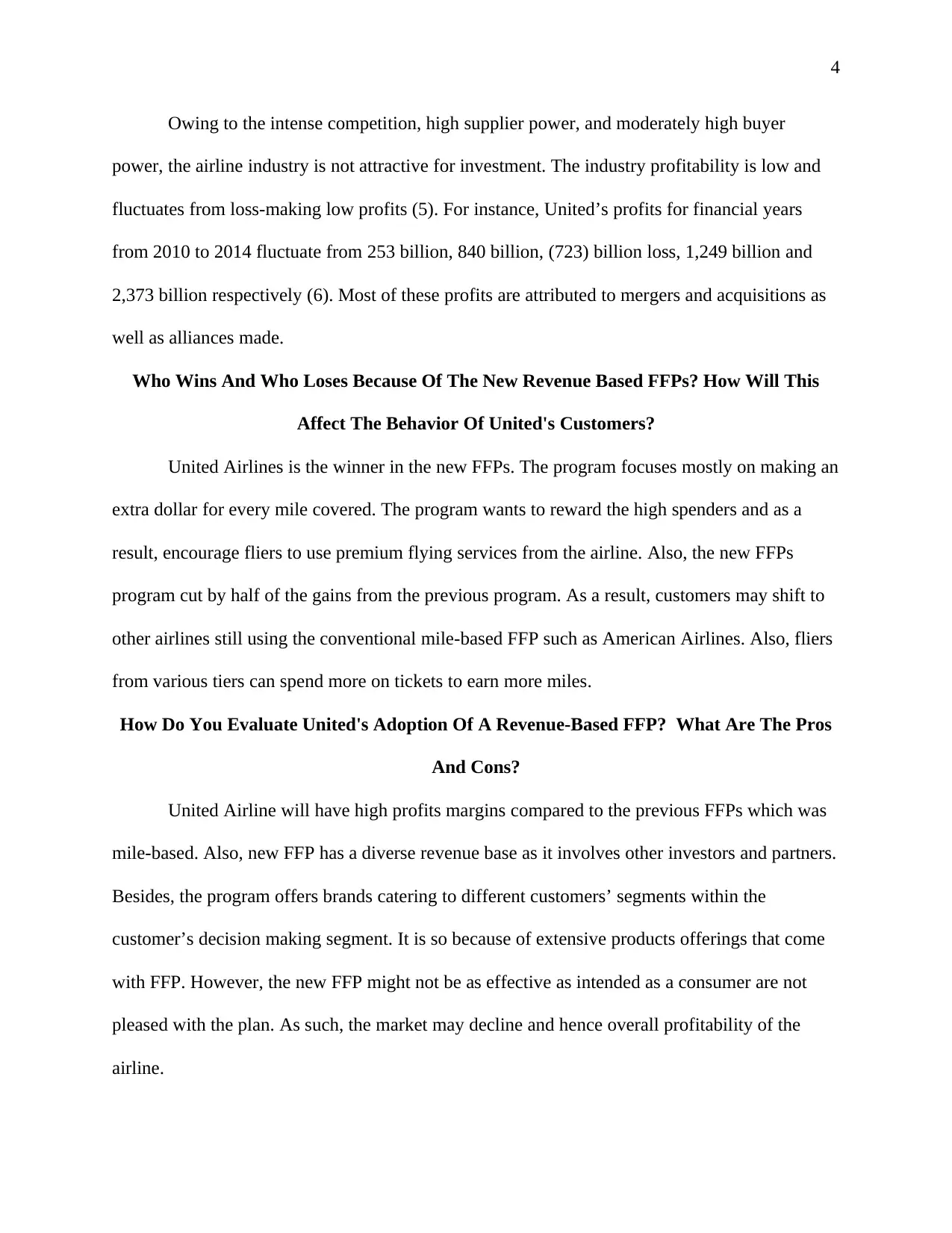
4
Owing to the intense competition, high supplier power, and moderately high buyer
power, the airline industry is not attractive for investment. The industry profitability is low and
fluctuates from loss-making low profits (5). For instance, United’s profits for financial years
from 2010 to 2014 fluctuate from 253 billion, 840 billion, (723) billion loss, 1,249 billion and
2,373 billion respectively (6). Most of these profits are attributed to mergers and acquisitions as
well as alliances made.
Who Wins And Who Loses Because Of The New Revenue Based FFPs? How Will This
Affect The Behavior Of United's Customers?
United Airlines is the winner in the new FFPs. The program focuses mostly on making an
extra dollar for every mile covered. The program wants to reward the high spenders and as a
result, encourage fliers to use premium flying services from the airline. Also, the new FFPs
program cut by half of the gains from the previous program. As a result, customers may shift to
other airlines still using the conventional mile-based FFP such as American Airlines. Also, fliers
from various tiers can spend more on tickets to earn more miles.
How Do You Evaluate United's Adoption Of A Revenue-Based FFP? What Are The Pros
And Cons?
United Airline will have high profits margins compared to the previous FFPs which was
mile-based. Also, new FFP has a diverse revenue base as it involves other investors and partners.
Besides, the program offers brands catering to different customers’ segments within the
customer’s decision making segment. It is so because of extensive products offerings that come
with FFP. However, the new FFP might not be as effective as intended as a consumer are not
pleased with the plan. As such, the market may decline and hence overall profitability of the
airline.
Owing to the intense competition, high supplier power, and moderately high buyer
power, the airline industry is not attractive for investment. The industry profitability is low and
fluctuates from loss-making low profits (5). For instance, United’s profits for financial years
from 2010 to 2014 fluctuate from 253 billion, 840 billion, (723) billion loss, 1,249 billion and
2,373 billion respectively (6). Most of these profits are attributed to mergers and acquisitions as
well as alliances made.
Who Wins And Who Loses Because Of The New Revenue Based FFPs? How Will This
Affect The Behavior Of United's Customers?
United Airlines is the winner in the new FFPs. The program focuses mostly on making an
extra dollar for every mile covered. The program wants to reward the high spenders and as a
result, encourage fliers to use premium flying services from the airline. Also, the new FFPs
program cut by half of the gains from the previous program. As a result, customers may shift to
other airlines still using the conventional mile-based FFP such as American Airlines. Also, fliers
from various tiers can spend more on tickets to earn more miles.
How Do You Evaluate United's Adoption Of A Revenue-Based FFP? What Are The Pros
And Cons?
United Airline will have high profits margins compared to the previous FFPs which was
mile-based. Also, new FFP has a diverse revenue base as it involves other investors and partners.
Besides, the program offers brands catering to different customers’ segments within the
customer’s decision making segment. It is so because of extensive products offerings that come
with FFP. However, the new FFP might not be as effective as intended as a consumer are not
pleased with the plan. As such, the market may decline and hence overall profitability of the
airline.
Paraphrase This Document
Need a fresh take? Get an instant paraphrase of this document with our AI Paraphraser
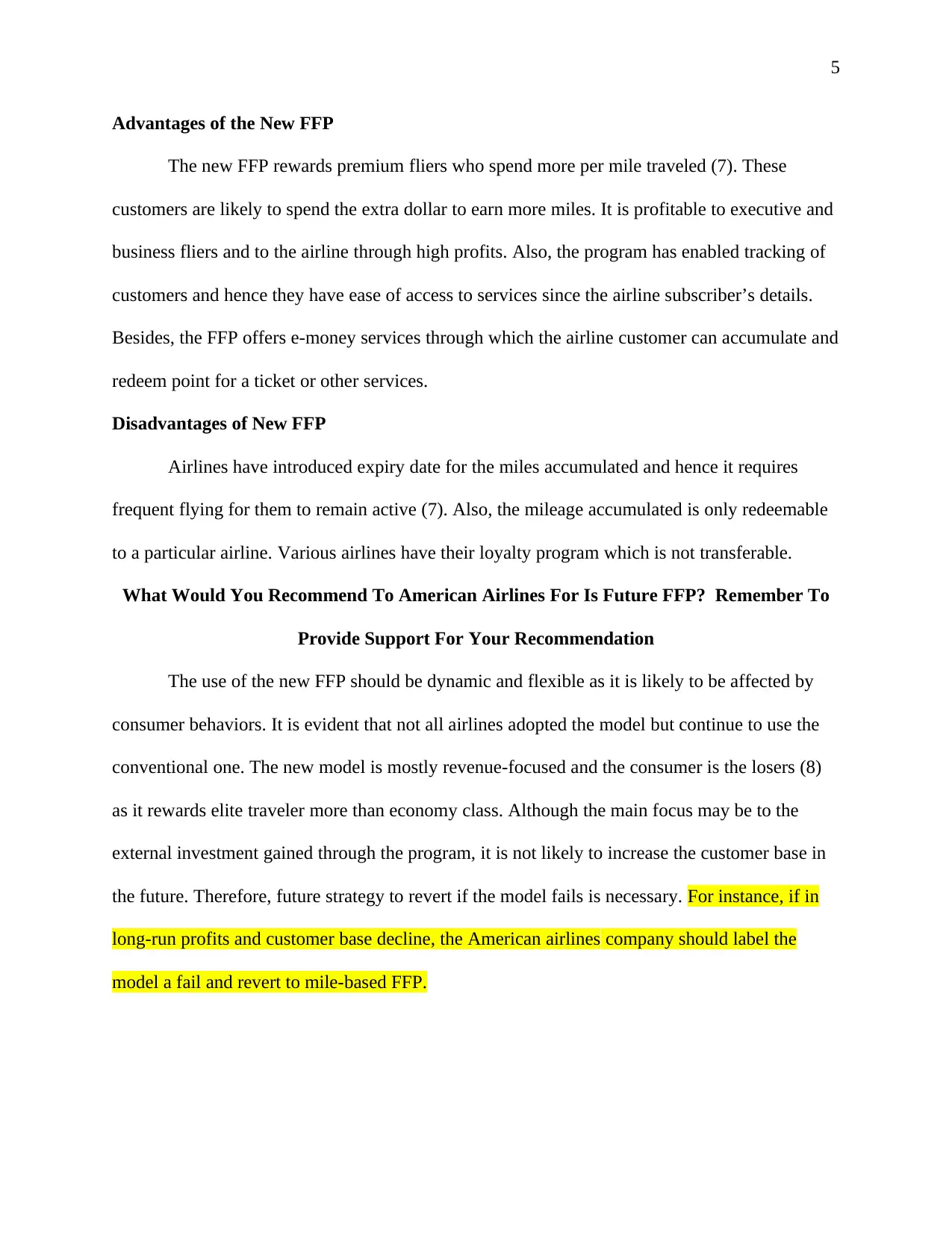
5
Advantages of the New FFP
The new FFP rewards premium fliers who spend more per mile traveled (7). These
customers are likely to spend the extra dollar to earn more miles. It is profitable to executive and
business fliers and to the airline through high profits. Also, the program has enabled tracking of
customers and hence they have ease of access to services since the airline subscriber’s details.
Besides, the FFP offers e-money services through which the airline customer can accumulate and
redeem point for a ticket or other services.
Disadvantages of New FFP
Airlines have introduced expiry date for the miles accumulated and hence it requires
frequent flying for them to remain active (7). Also, the mileage accumulated is only redeemable
to a particular airline. Various airlines have their loyalty program which is not transferable.
What Would You Recommend To American Airlines For Is Future FFP? Remember To
Provide Support For Your Recommendation
The use of the new FFP should be dynamic and flexible as it is likely to be affected by
consumer behaviors. It is evident that not all airlines adopted the model but continue to use the
conventional one. The new model is mostly revenue-focused and the consumer is the losers (8)
as it rewards elite traveler more than economy class. Although the main focus may be to the
external investment gained through the program, it is not likely to increase the customer base in
the future. Therefore, future strategy to revert if the model fails is necessary. For instance, if in
long-run profits and customer base decline, the American airlines company should label the
model a fail and revert to mile-based FFP.
Advantages of the New FFP
The new FFP rewards premium fliers who spend more per mile traveled (7). These
customers are likely to spend the extra dollar to earn more miles. It is profitable to executive and
business fliers and to the airline through high profits. Also, the program has enabled tracking of
customers and hence they have ease of access to services since the airline subscriber’s details.
Besides, the FFP offers e-money services through which the airline customer can accumulate and
redeem point for a ticket or other services.
Disadvantages of New FFP
Airlines have introduced expiry date for the miles accumulated and hence it requires
frequent flying for them to remain active (7). Also, the mileage accumulated is only redeemable
to a particular airline. Various airlines have their loyalty program which is not transferable.
What Would You Recommend To American Airlines For Is Future FFP? Remember To
Provide Support For Your Recommendation
The use of the new FFP should be dynamic and flexible as it is likely to be affected by
consumer behaviors. It is evident that not all airlines adopted the model but continue to use the
conventional one. The new model is mostly revenue-focused and the consumer is the losers (8)
as it rewards elite traveler more than economy class. Although the main focus may be to the
external investment gained through the program, it is not likely to increase the customer base in
the future. Therefore, future strategy to revert if the model fails is necessary. For instance, if in
long-run profits and customer base decline, the American airlines company should label the
model a fail and revert to mile-based FFP.
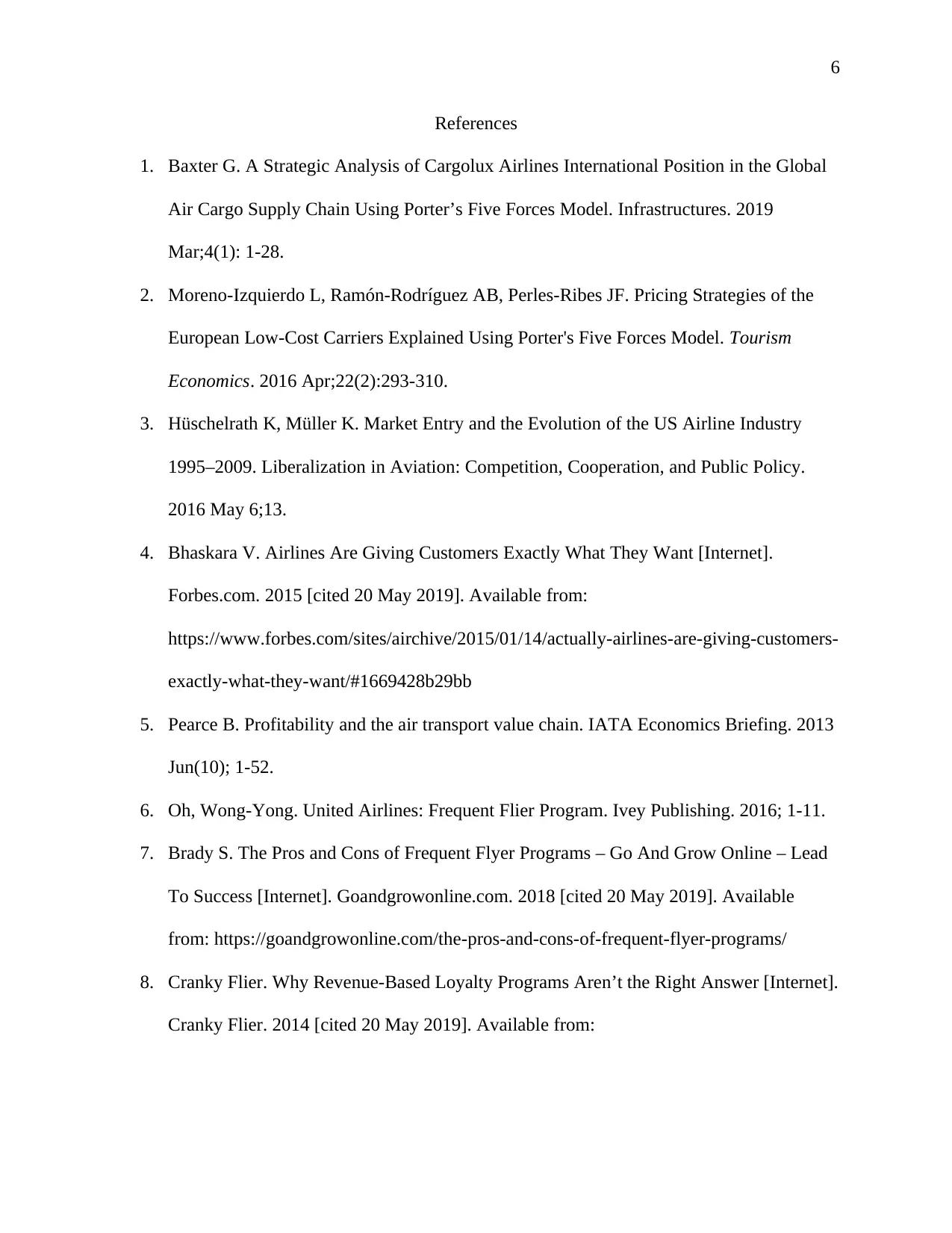
6
References
1. Baxter G. A Strategic Analysis of Cargolux Airlines International Position in the Global
Air Cargo Supply Chain Using Porter’s Five Forces Model. Infrastructures. 2019
Mar;4(1): 1-28.
2. Moreno-Izquierdo L, Ramón-Rodríguez AB, Perles-Ribes JF. Pricing Strategies of the
European Low-Cost Carriers Explained Using Porter's Five Forces Model. Tourism
Economics. 2016 Apr;22(2):293-310.
3. Hüschelrath K, Müller K. Market Entry and the Evolution of the US Airline Industry
1995–2009. Liberalization in Aviation: Competition, Cooperation, and Public Policy.
2016 May 6;13.
4. Bhaskara V. Airlines Are Giving Customers Exactly What They Want [Internet].
Forbes.com. 2015 [cited 20 May 2019]. Available from:
https://www.forbes.com/sites/airchive/2015/01/14/actually-airlines-are-giving-customers-
exactly-what-they-want/#1669428b29bb
5. Pearce B. Profitability and the air transport value chain. IATA Economics Briefing. 2013
Jun(10); 1-52.
6. Oh, Wong-Yong. United Airlines: Frequent Flier Program. Ivey Publishing. 2016; 1-11.
7. Brady S. The Pros and Cons of Frequent Flyer Programs – Go And Grow Online – Lead
To Success [Internet]. Goandgrowonline.com. 2018 [cited 20 May 2019]. Available
from: https://goandgrowonline.com/the-pros-and-cons-of-frequent-flyer-programs/
8. Cranky Flier. Why Revenue-Based Loyalty Programs Aren’t the Right Answer [Internet].
Cranky Flier. 2014 [cited 20 May 2019]. Available from:
References
1. Baxter G. A Strategic Analysis of Cargolux Airlines International Position in the Global
Air Cargo Supply Chain Using Porter’s Five Forces Model. Infrastructures. 2019
Mar;4(1): 1-28.
2. Moreno-Izquierdo L, Ramón-Rodríguez AB, Perles-Ribes JF. Pricing Strategies of the
European Low-Cost Carriers Explained Using Porter's Five Forces Model. Tourism
Economics. 2016 Apr;22(2):293-310.
3. Hüschelrath K, Müller K. Market Entry and the Evolution of the US Airline Industry
1995–2009. Liberalization in Aviation: Competition, Cooperation, and Public Policy.
2016 May 6;13.
4. Bhaskara V. Airlines Are Giving Customers Exactly What They Want [Internet].
Forbes.com. 2015 [cited 20 May 2019]. Available from:
https://www.forbes.com/sites/airchive/2015/01/14/actually-airlines-are-giving-customers-
exactly-what-they-want/#1669428b29bb
5. Pearce B. Profitability and the air transport value chain. IATA Economics Briefing. 2013
Jun(10); 1-52.
6. Oh, Wong-Yong. United Airlines: Frequent Flier Program. Ivey Publishing. 2016; 1-11.
7. Brady S. The Pros and Cons of Frequent Flyer Programs – Go And Grow Online – Lead
To Success [Internet]. Goandgrowonline.com. 2018 [cited 20 May 2019]. Available
from: https://goandgrowonline.com/the-pros-and-cons-of-frequent-flyer-programs/
8. Cranky Flier. Why Revenue-Based Loyalty Programs Aren’t the Right Answer [Internet].
Cranky Flier. 2014 [cited 20 May 2019]. Available from:
⊘ This is a preview!⊘
Do you want full access?
Subscribe today to unlock all pages.

Trusted by 1+ million students worldwide
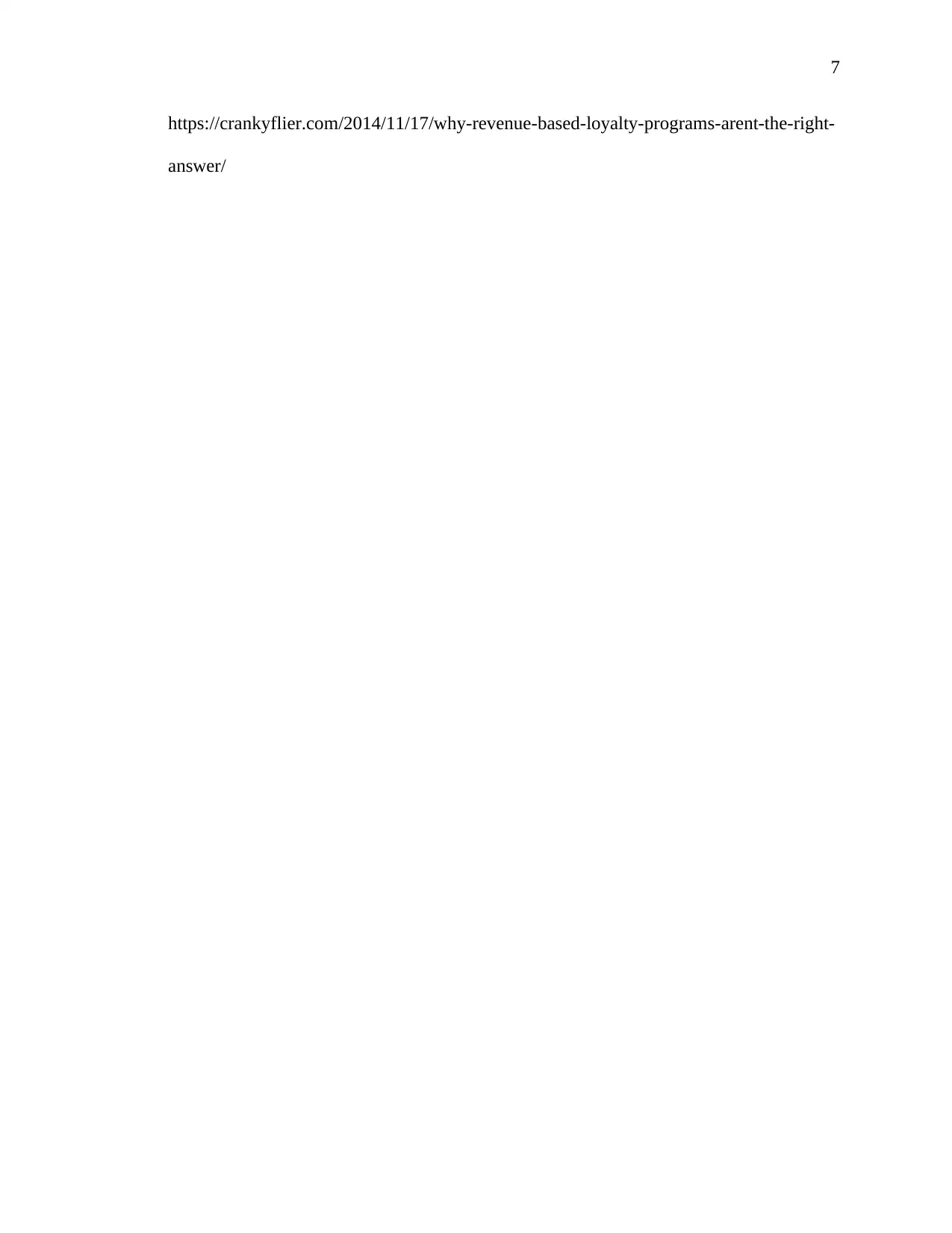
7
https://crankyflier.com/2014/11/17/why-revenue-based-loyalty-programs-arent-the-right-
answer/
https://crankyflier.com/2014/11/17/why-revenue-based-loyalty-programs-arent-the-right-
answer/
1 out of 7
Related Documents
Your All-in-One AI-Powered Toolkit for Academic Success.
+13062052269
info@desklib.com
Available 24*7 on WhatsApp / Email
![[object Object]](/_next/static/media/star-bottom.7253800d.svg)
Unlock your academic potential
Copyright © 2020–2025 A2Z Services. All Rights Reserved. Developed and managed by ZUCOL.





